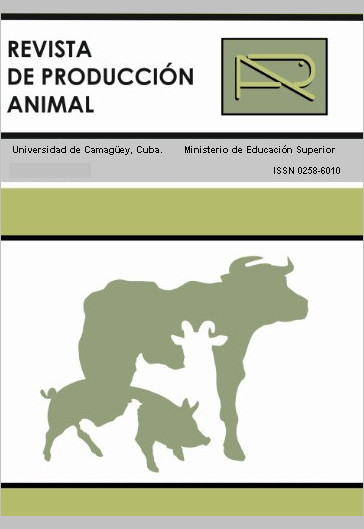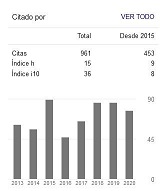Prevalence of Gastrointestinal Nematodes at Las Criollas Equine Unit, La Belén Ranch.
Resumen
The prevalence of gastrointestinal nematodes in 65 horses at Las Criollas, La Belén Ranch, from the National Enterprise for Wildlife Protection, in the province of Camagüey, Cuba, was determined. Parascaris equorumand Oxyu-ris equi´s spreading ways were identified by floating helminth-ovoscopic analysis. The rest of the species were clas-sified according to the morphological characteristics of previously cultured larvae. The formula referred by Vaklas Kouba to achieve temporary prevalence of parasitic nematodes was used in the study. The type with the highest prevalence found was Cyathostomas; the least was Parascaris equoromand Strongylus vulgaris. Other nematodes found were Strongylus edentatus, Gyalocephalus capitatus, Poteriostomumsp. Oesophagodontus robustus, Triodontophorussp, Trichostrongylus axeiand Strongyloide westeri.Descargas
Citas
ARUNDEL, J. H. (1985). Parasitic Diseases of the Horse. Veterinary Review, (28), 7-8.
CARDONA, E.; CHOPERENA, M.; QUIJANO, J. y LÓPEZ, G. (2005). Caracterización de nemátodos gastrointestinales de equinos que llegan a la central ganade-ra de Medellín. Parasitología. Revista Ciencias Pecuarias, (4), 384-385.
COLLOBERT-LAUGIER, C.; HOSTE, H.; KEVIN, C. y DORCHIES, P. (2002). Prevalence, Abundance and Site Distribution of Equine Small Strongyles in Normandy, France. Veterinary Parasitology, (110), 77-83.
CORTICELLI, B. y LAI, M. (1963). Ricerche Sulla Tecnica di Coltura Delle Larve Infestive Degli Strongili Gastro-Intestinali del Bovino. Acta Medica Veterinaria, (2), 7-8.
DEMEDIO, J.; MAIRELES, TERESAy CARTAS, J. O. (1984). Manual de Prácticas de Parasitología. La Habana, Cuba: Ed. EMPES.
DUNSMORE, J. D. y JUESUE, L. P. (1985). Prevalence and Epidemiology of the Major Gastrointestinal Parasites of Horses in Perth, Western Australia. Equine Veterinary, (3), 208-213.
ENGLISH, A. W. (1979). The Epidemiology of Equine Strongylosis in Southern Queensland. 2. The Sur-vival and Migration of Infective Larvae on Herbage. Aust. Veterinary,(7), 306-309.
HOGLUND, J.; LJUNGSTROM, B. L. et al.(1997). Occurrence of Gasterophilus intestinalisand Some Parasitic Nematodes of Horses in Sweden. Acta Vet. Scand, (2), 157-165. Extraído el 20 de marzo de 2009, desde http://www.ivis.org/advances/Carter_Equine/section3_helm/chapter.asp?LA=1#.
KOUBA, V. (1987). Epizootiología general (segunda edición). La Habana: Ed. Pueblo y Educación.
LICHTENFELS, J. R.; KHARCHENKO, V. A. y DVOJNOS, G. M. (2008). Illustrated Identification Keys to Strongylid Parasites (Strongylidae: Nematoda) of Horses, Zebras and Asses (Equidae). Vet Parasitol, 156(1-2), 4-161.
LYONS, E. T. y TOLLIVER, S. C. (2004). Prevalence of Parasite Eggs (Strongyloides westeri, Parascaris equorum, and Strongylus) and Oocysts (Emeria leuckarti) in the Feces of Thoroughbred foals on 14 Farms in Central Kentucky in 2003. Veterinary Parasitol., (5), 400-404.
LYONS, E. T. y DRUDGE, J. H. (1981). Prevalence of Strongylus vulgarisand Parascaris equorumin Kentucky Thoroughbreds at Necropsy. Vet. Med. Assoc., (8), 818-819.
LYONS, E. T.; TOLLIVER, S. C.; IONITA, M. y COLLINS, S. S. (2008). Evaluation of Parasiticidal Activity of Fenbendazole, Ivermectin, Oxibendazole, and Pyrantel Pamoate in Horse Foals with Emphasis on Ascarids (Parascaris equorum) in Field Studies on Five Farms in Central Kentucky in 2007.Veterinary Parasitol., (103), 287-291.
LYONS, E. T.; TOLLIVER, S. C.; COLLINS, S. S. (2006). Field Studies on Endoparasites of Thoroughbred Foals on Seven Farms in Central Kentucky. Veteri-nary Parasitol.,(98), 496-500.
MATTHEWS, J. B.; HODGKINSON, J. E.; DOWDALL, S. M. y PROUDMAN, C. J. (2004). Recent Developments in Research into the Cyathostominae and Anoplocephala perfoliata. Veterinary Research, (35), 371-381.
MFITILODZE, M. W. y HUTCHINSON, G. W. (1990). Prevalence and Abundance of Equine Strongyles (Nematoda: Strongyloidea) in Tropical Australia. VeterinaryParasitol., (4), 487-494.
MONAHAN, C. (2000). Estrategias de control de antihelmínticos para caballos. Extraído el 16 de septiembre de 2008, desde http://www.ivis.org/advances/Carter_Equine/section3_helm/chapter.asp?LA=1#.
NIELSEN, M. (2012). Sustainable Equine Parasite Control: Perspectives and Research Needs. Vet Parasitol., 185, 32-44.
OSTERMAN, Eva (2005). Prevalence and Control of Strongyle Nematode Infections of Horses in Sweden. Tesis de doctorado, Swedish University of Agricultural Sciences Uppsala, Faculty of Veterinary Medicine and Animal Science, Department of Biomedical Sciences and Veterinary Public Health.
OSTERMAN, Eva, RAUTALINKO, E.; UGGLA, A.; WALLER, P. J.; MORRISON, D. A. y HÖGLUND, J. (2007). Parasite Control Practices on Swedish Horse Farms. Acta Vet Scand., 49(1), 25.
PÉREZ, G. (2006). Quimioterapia de las enfermedades infecciosas y parasitarias. En Farmacología Veterinaria(2ª ed.; t. I). La Habana: Ed. Félix Varela.
PEINADO, R.; TORRES, L. y CAMPOS, M. (2011). Cierre del movimiento de rebaño equino de abril de 2011. Ponencia presentada en el curso Apreciadores de équidos, Centro Nacional de Control Pecuario, Ciego de Ávila, Cuba.
POYNTER, C. K. (1969). Desarrollo de los estróngilos. Ponencia presentada en la II Conferencia Internacional sobre Enfermedades de los Equinos, París, Francia.
RODRÍGUEZ, J.; ALONSO, M.; BLANDINO, TERESITA, B.; ABREU, R. y GÓMEZ, E. (1987). Manual de Técnicas Parasitológicas. La habana, Cuba: Ed. EMPES.
SALAS, J.; PADILLA, L.; BATISTA, B.; MENCHO, J. D.; GUERRA, Y. y MONTALBÁN, A. (2009). Prevalencia de las helmintiasis gastrointestinales equinas en el rancho San Vicente, provincia Camagüey. Rev. Prod. Anim., 20(1), 63-67.
SPSS (2006). SPSS para Windows(version 15.0.1).
TRAVERSA, D.; KLEI, T.; IORIO, R.; PAOLETTI, B.; LIA, R.; OTRANTO; D.; SPARAGANO, O. y GIANGASPERO, A. (2007). Occurrence of Anthelmintic Resistant Equine Cyathostome Populations in Central and Southern Italy. Preventive Veterinary Medicine, (82), 314-320.
VON SAMSON-HIMMELSTJERN, G. (2008). Anthelmintic Resistance in Equine Parasites. Potential Clinical Relevance and Implications for Control. An International Workshop Meeting for Developing Guidelines for the Diagnosis of Drug Resistance in Equine Parasites, Proceeding International Equine Parasite Drug Resistance Workshop on Faculty of Life Sciences, University of Copenhagen. Veterinary Parasitol., (137), 86-88.
VON SAMSON-HIMMELSTJERNA, G. (2012). Anthelmintic Resistance in Equine Parasites-Detection, Potential Clinical Relevance and Implications for Control. Vet. Parasitol., (185), 2-8.
Los autores de los artículos publicados en RPA retienen los derechos de autor de su trabajo, de marca y patente, y también sobre cualquier proceso o procedimiento descrito en el artículo, así como a compartir, copiar, distribuir, ejecutar y comunicar públicamente el artículo publicado en la RPA o cualquier parte de aquel siempre que indiquen la fuente de publicación (autores del trabajo, revista, volumen, número y fecha), pero están de acuerdo en que la revista publique los trabajos bajo una licencia Creative Commons.
![]() Licencia Attribution-NonCommercial 4.0 International (CC BY-NC 4.0)
Licencia Attribution-NonCommercial 4.0 International (CC BY-NC 4.0)






































